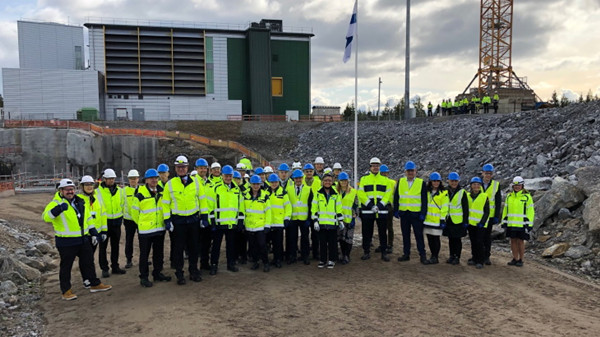Foundation stone laid for Finnish encapsulation plant
Finnish waste management company Posiva has laid the foundation stone for the start of construction of the used fuel encapsulation plant at the Olkiluoto site in western Finland. Construction of the plant is scheduled for completion in summer 2022.

Workers and dignitaries at the ceremony to mark the laying of the foundation stone (Image: Posiva)
The site for Posiva's repository at Eurajoki, near the Olkiluoto nuclear power plant, was selected in 2000. The Finnish parliament approved the decision-in-principle on the repository project the following year. Posiva - jointly owned by Finnish nuclear utilities Fortum and Teollisuuden Voima Oyj - submitted its construction licence application to the Ministry of Employment and the Economy in December 2013. Posiva studied the rock at Olkiluoto and prepared its licence application using results from the Onkalo underground laboratory, which would be expanded to form the basis of the repository. The government granted a construction licence for the project in November 2015 and construction work on the repository started a year later. Posiva is still required to obtain a separate operating licence for the facility.
Posiva's plan is for used fuel to be packed inside copper-steel canisters at an above-ground encapsulation plant, from where they will be transferred into the underground tunnels of the repository, located at a depth of 400-450 metres, and further into deposition holes lined with a bentonite buffer. Operation of the repository is expected to begin in 2023. The cost estimate of the construction project totals about EUR500 million (USD550 million) and it has an employment impact of around 2500 person years.
Posiva announced in June this year that it was ready to start construction of the encapssulation plant. It subsequently awarded Finnish construction company Skanska a contract for the implementation phase of the project. The value of the contract to Skanska is approximately EUR45 million. Skanska and Posiva signed a contract for the project preparation phase in November 2018.
On 23 September, Posiva announced that the foundation stone for the encapsulation plant had been laid. A ceremony marking the milestone was attended by: Finnish Prime Minister Antti Rinne; Posiva CEO and President Janne Mokka; Chairman of the Municipal Board of Eurajoki, Vesa Jalonen; Chairperson of the Eurajoki Municipal Council, Ilona Sjöman; and the CEO of Finnish construction company Skanska, Tuomas Särkilahti.
According to Mokka, the laying of the foundation stone is an important step in the long preparatory phase for the final disposal facility. "This demonstrates that we are proceeding in accordance with the plan defined already in the 1980s," he said. "The entire nuclear energy sector in Finland can take pride of the solution we have for the final disposal of used fuel, enabling us to start final disposal in a responsible manner. The laying of the foundation stone is perhaps a small step in terms of worksite progress, but a giant leap for final disposal, nuclear power and climate.
"We are now about to take the preparations for final disposal to the implementation stage of the facilities; a stage which is unique on the global scale. I feel particularly proud of Posiva's personnel who can boast world-class expertise in final disposal. Together with our competent partners we are making history in our industry."
Once commissioned, used fuel will be delivered in transportation casks to the receiving area of the encapsulation plant. This receiving area is also the place where the empty final disposal canisters are delivered. In the encapsulation plant, both the transportation cask and the final disposal canister will then be docked tightly inside the fuel handling cell, where the fuel is transferred from the transportation cask first to the drying station and then to the final disposal canister. When all fuel assemblies have been transferred to the canister, it will be filled with argon gas and then tightly closed with an inner steel cover.
From the handling cell, the filled canister will then be transferred to a welding station. Here the canister lid will be sealed with electron beam welding, which guarantees a tight and strong seam. Next, the tightness of the weld will be inspected at an inspection station using non-destructive testing methods, such as x-ray and ultrasonic testing.
Sweden is planning a similar used fuel encapsulation and disposal facility using the same storage method. Under its current timetable, national radioactive waste management company Svensk Kärnbränslehantering AB plans to start construction of the used fuel repository and the encapsulation plant sometime early in the 2020s and they will take about 10 years to complete.
- China Institute of Atomic Energy
- Nuclear Power Institute of China
- Southwestern Institute of Physics
- China Nuclear Power Operation Technology Corporation, Ltd.
- China Nuclear Power Engineering Co., Ltd.
- China Institute for Radiation Protection
- Beijing Research Institute of Uranium Geology (BRIUG)
- China Institute of Nuclear Industry Strategy (CINIS)
- China Nuclear Mining Science and Technology Corporation


